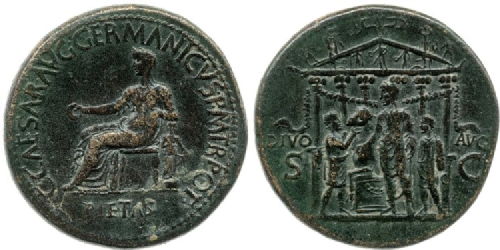A coin of Gaius (Caligula)
Oderint, dum metuant: ‘let them hate as long as they fear’, a quote commonly accredited to the reign of the Emperor Gaius or Caligula (AD 37-41). Gaius is frequently seen as a manic Emperor. Some speculate his madness derived from epilepsy in a time that had no treatment for this illness, leaving Gaius in a constant state of panic and paranoia. He is accused of sleeping with other men's wives and bragging about killing for mere amusement, deliberately wasting money on his bridge, causing starvation, and wanting a statue of himself erected in the Temple of Jerusalem for his worship, despite the governor Petronius warning him there would be 'rivers of blood'. Once, at some games at which he was presiding, he ordered his guards to throw an entire section of the crowd into the arena during intermission to be eaten by animals because there were no criminals to be prosecuted and he was bored. The later sources of Suetonius and Cassius Dio provide additional tales of insanity. They accuse Caligula of incest with his sisters, Agrippina the Younger, Drusilla, and Livilla, and say he prostituted them to other men. They state he sent troops on illogical military exercises, turned the palace into a brothel, and, most famously, planned or promised to make his horse, Incitatus, a consul and actually appointed him a priest.
 |
|
Sestertius of the emperor Caligula (RIC 1 36).
|
It seems hard to believe that one of the finest Julio-Claudian coins, with its exquisite detail, is from the reign of Caligula. The coin, shown above, suggests clever propagandizing. The reverse of this bronze sestertius, which was minted in Rome, depicts Caligula standing togate, whilst the attendants provide an insight into the attire of the early empire with one carrying an axe in his belt. The figure in the centre of the pediment of the temple wielding a spear and patera is likely Divus Augustus. On the left edge of pediment is either Mars or Romulus. On the right corner of the pediment is Aeneas, Ascanius and Anchises, a commonly reoccurring scene in art and architecture. This group communicated legitimacy through descent from Aeneas, fitting since Gaius’ rule was incredibly tenuous. The DIVO AVG clearly refers to the temple of Augustus. Interestingly the plan to build the temple of the deified Augustus was initiated by Tiberius in AD 20, but it was Caligula who opened and finally dedicated the building. The obverse displays pietas, veiled and draped, seated left, holding a patera in her right hand and resting her left arm on a small draped figure, which stands on a base.

This month's coin was selected by Alfred Wrigley. Alfred is a 1st year Ancient History and Classical Archaeology student who has a great interest in Julio-Claudian numismatics, with particular emphasis on Gaius.
 Clare Rowan
Clare Rowan


 Loading…
Loading…
Florence Isobel
Great article
02 Feb 2015, 19:38
Add a comment
You are not allowed to comment on this entry as it has restricted commenting permissions.